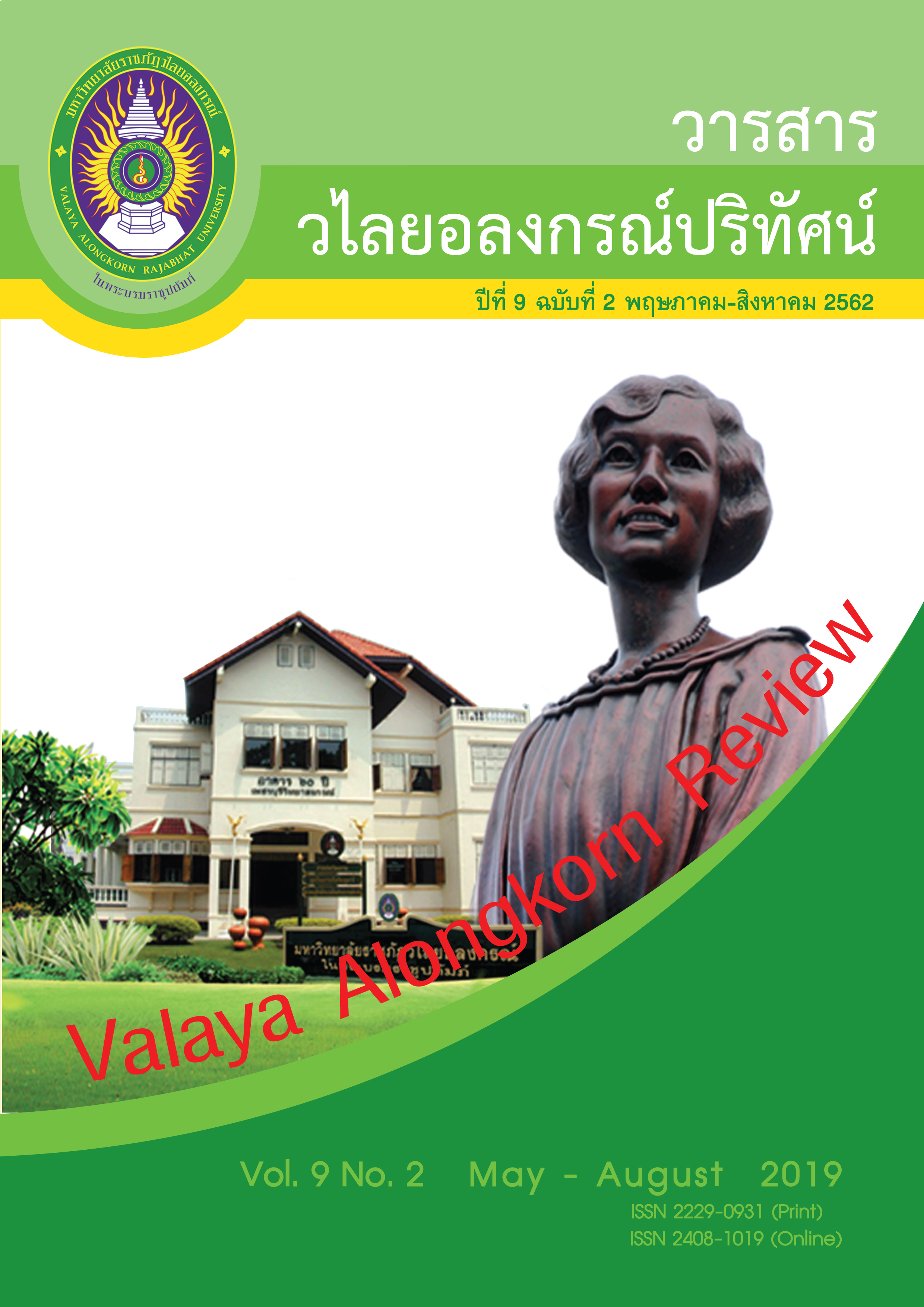การพัฒนาแนวทางการจัดกิจกรรมพัฒนาผู้เรียนด้านกิจกรรมแนะแนว สำหรับสถานศึกษา สังกัดสำนักงานเขตพื้นที่การศึกษาประถมศึกษาหนองบัวลำภู เขต 2
คำสำคัญ:
กิจกรรมแนะแนว, แนวทางการจัด, กิจกรรมพัฒนาผู้เรียนบทคัดย่อ
การวิจัยครั้งนี้มีวัตถุประสงค์เพื่อ 1) ศึกษาสภาพปัจจุบัน และสภาพที่พึงประสงค์ ของการจัดกิจกรรมพัฒนาผู้เรียนด้านกิจกรรมแนะแนว สำหรับสถานศึกษา สังกัดสำนักงานเขตพื้นที่การศึกษาประถมศึกษาหนองบัวลำภูเขต 2 และ 2) พัฒนาแนวทางการจัดกิจกรรมพัฒนาผู้เรียน ด้านกิจกรรมแนะแนว สำหรับสถานศึกษา สังกัดสำนักงานเขตพื้นที่การศึกษาประถมศึกษาหนองบัวลำภู เขต 2 ประชากร ได้แก่ ครู ในโรงเรียนขยายโอกาส สังกัดสำนักงานเขตพื้นที่การศึกษาประถมศึกษาหนองบัวลำภูเขต 2 ที่ปฏิบัติงานในปีการศึกษา 2561 จำนวน 639 คน จากจำนวนโรงเรียน 32 โรงเรียน กลุ่มตัวอย่าง ได้แก่ ครู ในโรงเรียนขยายโอกาส สังกัดสำนักงานเขตพื้นที่การศึกษาประถมศึกษาหนองบัวลำภูเขต 2 ที่ปฏิบัติงานในปีการศึกษา 2561 จำนวน 242 คน ได้จากการเปิดตารางของเครจซี่และมอร์แกน (Krejcie & Morgan) โดยใช้เทคนิคการสุ่มตัวอย่างแบบง่าย (Simple Random Sampling) การดำเนินการเก็บรวบรวมข้อมูลแบ่งออกเป็น 2 ระยะ ดังนี้ ระยะที่ 1 เก็บข้อมูลจากกลุ่มตัวอย่างที่เป็นโรงเรียนขยายโอกาส สังกัดสำนักงานเขตพื้นที่การศึกษาประถมศึกษาหนองบัวลำภู เขต 2 และศึกษาโรงเรียนที่มีวิธีปฏิบัติที่ดีเกี่ยวกับการจัดกิจกรรมพัฒนาผู้เรียน ด้านกิจกรรมแนะแนว สถิติที่ใช้ในการวิเคราะห์ข้อมูล ได้แก่ ร้อยละ ค่าเฉลี่ย ส่วนเบี่ยงเบนมาตรฐาน การวิเคราะห์เนื้อหา ระยะที่ 2 ประเมินความเหมาะสมและความเป็นไปได้ของแนวทางการจัดกิจกรรมพัฒนาผู้เรียนด้านกิจกรรมแนะแนว สำหรับสถานศึกษา สังกัดสำนักงานเขตพื้นที่การศึกษาประถมศึกษาหนองบัวลำภูเขต 2 โดยผู้ทรงคุณวุฒิ 5 ท่าน สถิติที่ใช้ในการวิเคราะห์ข้อมูล ได้แก่ ค่าเฉลี่ย ส่วนเบี่ยงเบนมาตรฐาน
ผลการวิจัยพบว่า
1. การจัดกิจกรรมพัฒนาผู้เรียนด้านกิจกรรมแนะแนว สำหรับสถานศึกษา สังกัดสำนักงานเขตพื้นที่การศึกษาประถมศึกษาหนองบัวลำภูเขต 2 มีองค์ประกอบของกิจกรรมแนะแนว 5 ด้าน คือ 1) การเก็บรวบรวมข้อมูล PNImodified = 0.31 2) ข้อมูลสารสนเทศ PNImodified =0.32 3) การให้คำปรึกษา PNImodified = 0.36 4) การจัดวางตัวบุคคล PNImodified = 0.42 5) การติดตามผลและประเมินผล PNImodified = 0.40 สภาพปัจจุบันของการจัดกิจกรรมพัฒนาผู้เรียนด้านกิจกรรมแนะแนว สำหรับสถานศึกษา สังกัดสำนักงานเขตพื้นที่การศึกษาประถมศึกษาหนองบัวลำภูเขต 2 โดยรวมและรายด้านพบว่าอยู่ในระดับปานกลางทุกด้าน เรียงลำดับจากมากไปน้อย ได้แก่ 1) ข้อมูลสารสนเทศ 2) การเก็บรวบรวมข้อมูล 3) การให้คำปรึกษา 4) การจัดวางตัวบุคคล และ 5) การติดตามผลและประเมินผล ตามลำดับ ส่วนสภาพที่พึงประสงค์ของการจัดกิจกรรมพัฒนาผู้เรียน ด้านกิจกรรมแนะแนวสำหรับสถานศึกษา สังกัดสำนักงานเขตพื้นที่การศึกษาประถมศึกษาหนองบัวลำภูเขต 2 โดยรวมอยู่ในระดับมากที่สุด และเมื่อพิจารณาเป็นรายด้านพบว่า อยู่ในระดับมากที่สุด 4 ด้านเรียงลำดับจากมากไปน้อย ได้แก่ 1) การให้คำปรึกษา 2) การจัดวางตัวบุคคล 3) ข้อมูลสารสนเทศ 4) การเก็บรวบรวมข้อมูล ตามลำดับ และอยู่ในระดับมาก 1 ด้าน ได้แก่ 5) การติดตามผลและประเมินผล
2. ผลการประเมิน การพัฒนาแนวทางการจัดกิจกรรมพัฒนาผู้เรียน ด้านกิจกรรมแนะแนว สำหรับสถานศึกษา สังกัดสำนักงานเขตพื้นที่การศึกษาประถมศึกษาหนองบัวลำภูเขต 2 พบว่าโดยรวมมีความเหมาะสมอยู่ในระดับมากที่สุด และเมื่อพิจารณาเป็นรายด้านพบว่า มีความเหมาะสมและความเป็นไปได้ อยู่ในระดับมากที่สุดทุกด้าน เรียงลำดับจากมากไปหาน้อย ได้แก่ 4) การจัดวางตัวบุคคล 3) การให้คำปรึกษา 5) การติดตามผลและประเมินผล 2) ข้อมูลสารสนเทศ 1) การเก็บรวบรวมข้อมูล ตามลำดับ ส่วนความเป็นไปได้โดยรวมอยู่ในระดับมากที่สุด และเมื่อพิจารณารายด้านพบว่าอยู่ในระดับมากที่สุดทั้ง 5 ด้าน เรียงลำดับจากมากไปหาน้อย ได้แก่ 4) การจัดวางตัวบุคคล 5) การติดตามผลและประเมินผล 3) การให้คำปรึกษา 2) ข้อมูลสารสนเทศ 1) การเก็บรวบรวมข้อมูล ตามลำดับ
เอกสารอ้างอิง
กรมวิชาการ. (2551). หลักสูตรแกนกลางการศึกษาขั้นพื้นฐาน พุทธศักราช 2551. กรุงเทพฯ: คุรุสภาลาดพร้าว.
เกศรา น้องคะนึง. (2560). การพัฒนาแนวทางการบริหารงานแนะแนวโรงเรียนในสังกัดสำนักงานเขตพื้นที่การศึกษามัธยมศึกษา เขต 20. วิทยานิพนธ์ศึกษาศาสตรมหาบัณฑิตมหาวิทยาลัยมหาสารคาม.
จรุณรักษ์ ยี่ภู่ และคณะ. (2561). การพัฒนารูปแบบกิจกรรมการเรียนรู้ โดยโปรแกรมการฝึกควบคุมพฤติกรรมตนเองเพื่อ ลด ละ เลิก พฤติกรรมการสูบบุหรี่ ของผู้ป่วยยาเสพติดเด็กและวัยรุ่น. วารสารวไลยอลงการณ์ปริทัศน์. 8(1): 113-146.
บุญชม ศรีสะอาด. (2553). การวิจัยเบื้องต้น. (พิมพ์ครั้งที่ 7). กรุงเทพฯ: สุวีริยาสาส์น.
พักรบ อำนวยผล. (2552). การบริหารงานแนะแนวในโรงเรียน สังกัดเทศบาลนครเชียงราย. วิทยานิพนธ์คุรุศาสตรมหาบัณฑิต มหาวิทยาลัยราชภัฏเชียงราย.
สำนักงานเขตพื้นที่การศึกษาประถมศึกษาหนองบัวลำภู เขต 2. (2560). แผนพัฒนาการศึกษา 2560. หนองบัวลำภู: พี.ที.นากลาง.
สำนักงานคณะกรรมการพัฒนาการเศรษฐกิจและสังคมแห่งชาติ. (2559). แผนพัฒนาเศรษฐกิจและสังคมแห่งชาติ ฉบับที่ 12 (2560-2564). กรุงเทพฯ: สำนักนายกรัฐมนตรี.
สำนักวิชาการและมาตรฐานการศึกษาสำนักงานคณะกรรมการการศึกษาขั้นพื้นฐาน. (2554). คู่มือแนวทางการจัดกิจกรรมแนะแนวระดับประถมศึกษา. กรุงเทพฯ: ชุมนุมสหกรณ์การเกษตรแห่งประเทศไทย.
ดาวน์โหลด
เผยแพร่แล้ว
รูปแบบการอ้างอิง
ฉบับ
ประเภทบทความ
สัญญาอนุญาต
ข้อความที่ปรากฏในบทความแต่ละเรื่องในวารสารวไลยอลงกรณ์ปริทัศน์ เป็นความคิดเห็นของผู้นิพนธ์แต่ละท่าน มิใช่เป็นทัศนะและมิใช่ความรับผิดชอบของกองบรรณาธิการจัดทำวารสาร และ
มหาวิทยาลัยราชภัฏวไลยอลงกรณ์ ในพระบรมราชูปถัมภ์


